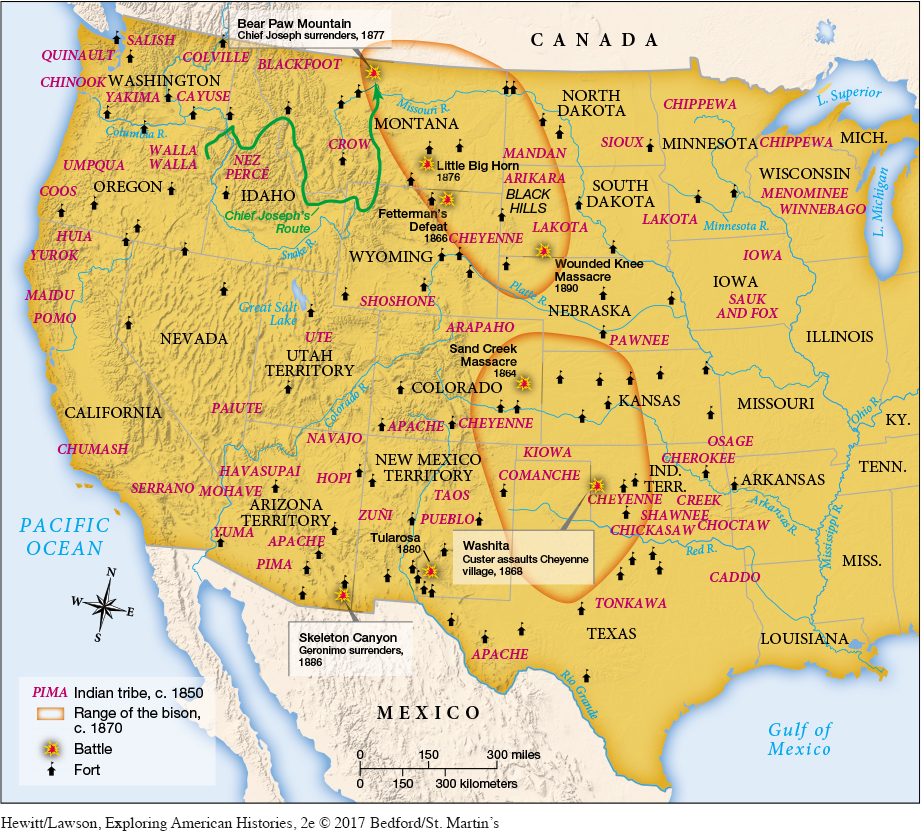Indian Civilizations
Long before white settlers appeared, the frontier was already home to diverse peoples. The many native groups who inhabited the West spoke distinct languages, engaged in different economic activities, and competed with one another for power and resources. The descendants of Spanish conquistadors had also lived in the Southwest and California since the late sixteenth century, pushing the boundaries of the Spanish empire northward from Mexico. Indeed, Spaniards established the city of Santa Fe as the territorial capital of New Mexico years before the English landed at Jamestown, Virginia, in 1607.
By the end of the Civil War, around 350,000 Indians were living west of the Mississippi. They constituted the surviving remnants of the 1 million people who had occupied the land for thousands of years before Europeans set foot in America. Nez Percé, Ute, and Shoshone Indians lived in the Northwest and the Rocky Mountain region; Lakota, Cheyenne, Blackfoot, Crow, and Arapaho tribes occupied the vast expanse of the central and northern plains; and Apaches, Comanches, Kiowas, Navajos, and Pueblos made up the bulk of the population in the Southwest. Some of the tribes, such as the Cherokee, Creek, and Shawnee, had been forcibly removed from the East during Andrew Jackson’s presidency in the 1830s.
Given the rich assortment of Indian tribes, it is difficult to generalize about Indian culture and society. The tribes each adapted in unique ways to the geography and climate of their home territories, spoke their own language, and had their own history and traditions. Some were hunters, others farmers; some nomadic, others sedentary. In New Mexico, for example, Apaches were expert horsemen and fierce warriors, while the Pueblo Indians built homes out of adobe and developed a flourishing system of agriculture. Also, they cultivated the land through methods of irrigation that foreshadowed modern practices. The Pawnees in the Great Plains periodically set fire to the land to improve game hunting and the growth of vegetation. Indians on the southern plains gradually became enmeshed in the market economy for bison robes, which they sold to American traders (Map 15.2).

The lives of all Indian peoples were affected by the arrival of Europeans, but the consequences of cross-cultural contact varied considerably depending on the history and circumstances of each tribe. Whites trampled on Indian hunting grounds, polluted streams with acid run-off from mines, and introduced Indians to liquor. They inflicted the greatest damage through diseases for which Indians lacked the immunity that Europeans and white Americans had acquired. By 1870, smallpox had wiped out half the population of Plains Indians, and cholera, diphtheria, and measles caused serious but lesser harm. Nomadic tribes such as the Lakota Sioux were able to flee the contagion, while agrarian tribes such as the Mandan suffered extreme losses. As a result, the balance of power among Plains tribes shifted to the more mobile Sioux. Indians were not pacifists, and they engaged in warfare with their enemies in disputes over hunting grounds, horses, and honor. However, the introduction of guns by European and American traders transformed Indian warfare into a much more deadly affair than had existed previously. And by the mid-nineteenth century, some tribes had become so deeply engaged in the commercial fur trade with whites that they had depleted their own hunting grounds.
Native Americans had their own approach toward nature and the land they inhabited. Most tribes did not accept private ownership of land, as white pioneers did. Indians recognized the concept of private property in ownership of their horses, weapons, tools, and shelters, but they viewed the land as the common domain of their tribe, for use by all members. “The White man knows how to make everything,” the Hunkpapa Lakota chieftain Sitting Bull remarked, “but he does not know how to distribute it.” This communitarian outlook also reflected native attitudes toward the environment. Indians considered human beings not as superior to the rest of nature’s creations, but rather as part of an interconnected world of animals, plants, and natural elements. According to this view, all plants and animals were part of a larger spirit world, which flowed from the power of the sun, the sky, and the earth.
Explore
See Document 15.1 for a depiction of buffalo hunting.
Bison (commonly known as buffalo) played a central role in the religion and society of many Indian tribes. By the mid-nineteenth century, approximately thirty million bison grazed on the Great Plains. Before acquiring guns, Indians used a variety of means to hunt their prey, including bows and arrows and spears. Some rode their horses to chase bison and stampede them over cliffs. The meat from the buffalo provided food; its hide provided material to construct tepees and make blankets and clothes; bones were crafted into tools, knives, and weapons; dried bison dung served as an excellent source of fuel. It is therefore not surprising that the Plains Indians dressed up in colorful outfits, painted their bodies, and danced to the almighty power of the buffalo and the spiritual presence within it.
Indian hunting societies, such as the Lakota Sioux and Apache, contained gender distinctions. The task of riding horses to hunt bison became men’s work; women waited for the hunters to return and then prepared the buffalo hides. Nevertheless, women refused to think of their role as passive; they saw themselves as sharing in the work of providing food, shelter, and clothing for the members of their tribe. Similarly, the religious belief that the spiritual world touched every aspect of the material world gave women an opportunity to experience this transcendent power without the mediation of male leaders.
Exploring American HistoriesPrinted Page 488
Exploring American Histories Value EditionPrinted Page 360
Chapter Timeline